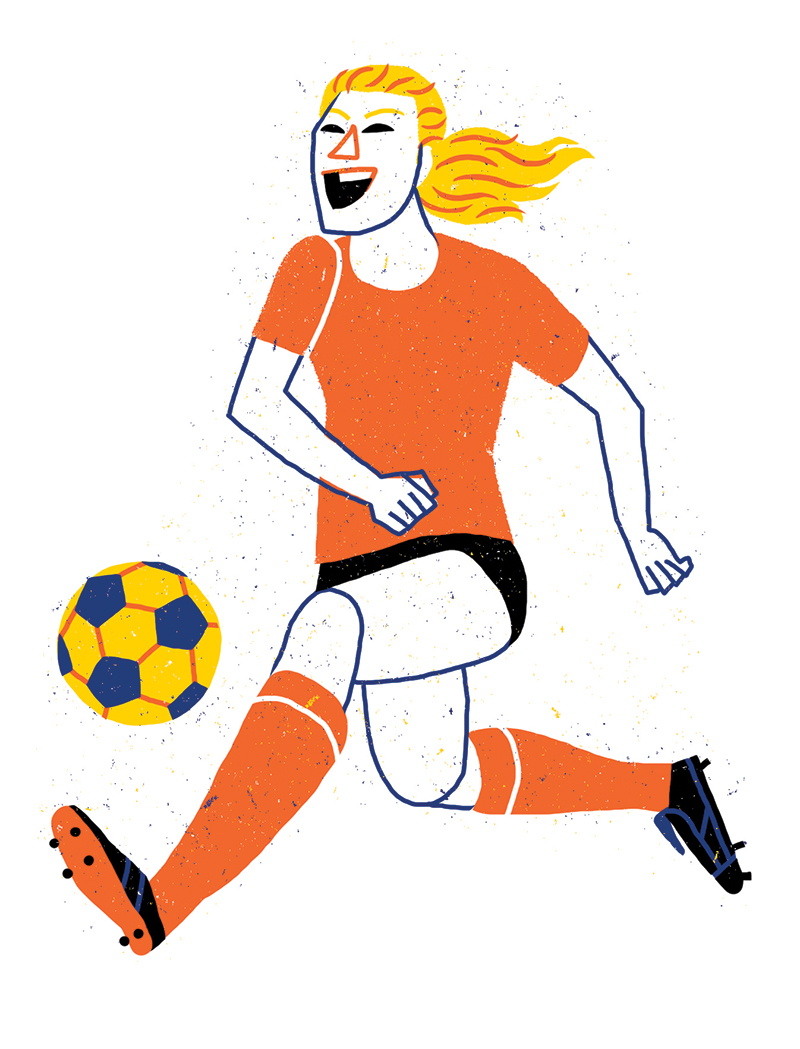Free to play
What happens when a woman is the best on the playing field? Three stories teach us that merit always goes beyond gender.
by Tino Mantarro

<span style="font-weight: 400;">There are many ways to be a goalkeeper, but none of them are easy. Whatever you call them, goalies, goaltenders, or netminders, their jerseys have a number 1 on the back – or at least did until numbers became a sort of trademark – because the goalkeeper is the first to take the blame. Sure, goals are scored against the whole team, but the one really beaten is the goalkeeper. So, as Eduardo Galeano said, they should be called martyrs. Even if you don’t know anything about football, it’s clear that standing between those posts is not at all easy. Also because mothers tend to not like to see their children crash to the ground and get their clothes dirty. And if you are a girl and live in Spain in the ’20s of the twentieth century, choosing to be a goalkeeper is not only difficult, it is impossible. Because soccer is a game for hombres, for men, for males. And the idea that there is a women’s soccer is just not an option. There is soccer, and that’s it.
Instead, Irene González Basanta, a young girl born in 1909 in La Coruña, Galicia, wanted to play soccer. In fact, she wanted to be a goalkeeper, a role in which she was strong, very strong. Since she was a child, she played soccer in her neighborhood’s dirt fields, at Atocha, just a step away from the Atlantic coast. They say she was a striker to start with, but the role doesn’t matter much at that age. At twelve years old, she played between the posts in a team of teenagers, Orillamar. She was the only girl at games surrounded by 21 men, but Irene didn’t seem to care. She also didn’t care that they called her a tomboy and accused her of being homosexual. She wasn’t on an ideological crusade for women’s rights, and even if she had been, we haven’t heard about it. What we do know is that soccer was her passion, and she did not intend to give it up.

Determined and proactive, after playing and making an impression in the ranks of Racing Coruñes, at the end of 1924, she founded a team that bore her name, the Irene Futbòl Club. She was both captain and coach of Irene FC, because back then, there were no coaches in youth teams. Obviously, she was also the only woman on the team, but that wasn’t a problem for her and the other ten players. Nor was it a problem for Eduardo González Valiño, also known as Cacho, who alongside Irene had started kicking those heavy leather balls with embossed seams that were used at the time. Cacho was destined to make his way in soccer: a few years later he ended up at Atletico Madrid, which at the time was already the elite of Spanish soccer, and played for the Furias Rojas, the Spanish national team, with which he still holds the record for the most goals in a single game, six, in 1933 against Bulgaria. This is to say that in Galicia, in 1925, the fact that there was a woman between the posts was not seen as a problem, quite the contrary. On the other hand, in liberal England, the country where football originated and where the first official women’s game was played on 23 March 1895, the Football Association had already banned women from the fields in 1921 saying: “the game of football is quite unsuitable for females and ought not to be encouraged.”
In liberal England, the country where football originated and where the first official women’s game was played on 23 March 1895, the Football Association had already banned women from the fields in 1921 saying: “the game of football is quite unsuitable for females and ought not to be encouraged.”
Confusion was rampant in those years in the far north of Spain. There was no real organized local championship, but matches were played everywhere. So, Irene FC played both in a city championship with other amateur teams of the Galician capital and in a long series of friendly matches with amateur teams competing in the national championships. The games drew a fairly large audience of gentlemen in suits and bowler hats who paid a ticket to see her, Irene. Money with which she silenced her family, who frowned upon her dedication to soccer.
They say that before every match, she used to put a rag doll dressed as a footballer at the back of the net. It was not a “girly” thing, but rather the same superstitious ritual of her idol, the divine Ricardo Zamora, the most outstanding Spanish goalkeeper of all time. Far from being a circus freak, Irene González Basanta was a good goalkeeper. The local newspapers of the time featured her “formidable shot,” the “difficulty in shooting past her,” “her ability out of the box,” and her attitude of never giving up, even when there was a fight, and she had to earn respect. After all, Irene was the captain, and shouted instructions to her companions in the defense from the net. In one of the only two photos that portray her, published in 1925 in the newspaper El Orzán, she is leaning against the goalpost, dressed elegantly in a white jersey with a large black V sewn on it, a wide black divided skirt, just above the knee, long socks, knee pads, and shoes with cleats. Her hands were bare because they didn’t use gloves back then. Her gaze was bold, saucy, confident, and proud.

Quite different from that of Ana Carmona Ruíz, called Nita, almost her exact age (she was born in 1908) but a native of the deep south of Andalusia, in Málaga. Nita shared the same passion for football as Irene, but the only picture in which she can be clearly seen in a football uniform was taken during a Carnival, when everything goes.
Her story is the exact opposite of Irene’s: to play soccer, she had to deny her identity, pretend to be a boy, and disguise herself as a male. The daughter of a longshoreman in the city port, Nita grew up on the docks watching the English sailors coming from Gibraltar play “Fútbol.” And there, she must have fallen in love with this modern sport to the point of being arrested for playing it. Traditionalist Andalusia was certainly not progressive Galicia.
Nita began to play on the pitch of a parish school run by a Salesian priest, Francisco Míguez Hernández, who happened to be from Galicia and a big fan of this new sport, soccer, which he praised for its educational value for young people. Nita went to the field and played alone. When there were matches, she helped her grandmother wash the players’ uniforms, then she set foot on the field carrying the masseur’s canteens, and finally – thanks to the help of Don Francisco – once when a player was missing, she got to play in the field wearing the vertical striped jersey of Sporting Club Malaga. With her massive physique and square jaw, Nita stood out for her physicality in that corral of sweaty men: she was 1.79 meters tall, whereas, at the time, the average height of Spaniards was no more than 1.69 meters. A midfielder with good lungs and speed, she knew how to play the game and didn’t hesitate to score. In short, she deserved her place on the team, but she couldn’t play showing her face like Irene did. To play, Nita had to wear a cotton band that restrained her breasts, wear loose t-shirts and shorts and cover her hair with a band, a habit that was quite common among soccer players in those years who often wore it to protect their foreheads from the laces of leather balls.
Nita couldn’t play showing her face like Irene did. To play, Nita had to wear a cotton band that restrained her breasts, wear loose t-shirts and shorts and cover her hair with a ban.
But her strength, stronger than many men who lost their place to her among the eleven, provoked envy and gossip. Envy that turned into slander when someone from her own team reported to the authorities: at the Segalerba field, there was a woman playing soccer. It was a scandal that cost her a charge for disorderly conduct, arrest, and the ensuing shaving of her hair as a sign of infamy. Not only that, the family, who was unaware of their daughter’s passion, drove her away from the city in the hope that she would get over those strange inclinations. It was 1926, and she had to move to Vélez. There, thanks to a cousin, she began to play for Vélez FC, an amateur team whose players were paid in goods: a piece of cloth, a supply of leather, a handful of pesetas when everything went well. Here, too, Nita played dressed as a man, entering the locker room as a bottle bearer, leaving as a soccer player. In the official lists given to the referees at the beginning of the match, instead of her name, they wrote her new nickname, “Veleta” – weather vane – and that was it. The chronicles recount that at the end of the game, “Veleta” was often the best player on the field. But since in the village her story was well-known and her face was well known, Veleta was forced to play only away games, where hardly anyone could recognize her. Yet “Veleta” was troublesome. They say that when an official league was formed in Andalusia, the Federación Sur, they sent spies to see if she was playing or not. Then the League of Referees made it official that women were forbidden to play on the field, and the career ended for Nita, aka Veleta.
Irene and Nita have another aspect of their lives in common besides soccer. They died young. Irene, not even twenty years old, died of tuberculosis; Nita, 32 years old, died of exanthematous typhus. In the last pages of their game, the poor girls from poor families were helped by those who had admired them on the field. To commemorate their achievements, a newspaper of La Coruña raised funds for Irene’s care; Nita’s teammates paid for her funeral. Both wanted to be buried wearing the jersey of their soccer team. Not the one they were supporters of, as often happens, but the one they played with, alongside the men. Without clamor, with passion, because sport is sport, not a matter of gender.



 in Italy
in Italy